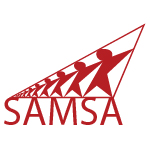SAMSA was founded in 1981 by a group of mathematicians in the Southern African countries who were concerned with furtherance of mathematical sciences in the region. The nucleus member countries included those from the conglomeration then called the Southern African Development Coordination Council (SADCC) with the provision that countries outside this region may apply to join. Today, the association boasts of membership from countries beyond Southern Africa, including Uganda in Eastern Africa, Norway and UK in Europe, and USA. The first ever SAMSA conference was held in Botswana in 1981. Since then annual conferences have taken place without fail, rotating in the member countries. See Previous Conferences under Meetings. The primary goal of SAMSA is to further the mathematical sciences in the Southern African Region and beyond.
SAMSA has also been involved in capacity building programs for the region through various projects and programmes. For instant, SAMSA was instrumental in the establishment of the regional Southern African masters student programme called Mathematical Modeling that was successfully hosted at the University of Zimbabwe (UZ) from 1996 – 2007 initiated by Professor Bernt Øksendal of the University of Oslo, and supported by the Norwegian government through the Norwegian Universities Aid Programme, NUFU. The program trained well over 60 MSc students, most, if not all of whom went on to do PhDs mostly in Europe and South Africa. These together with others trained through other programmes, are now contributing tremendously in mathematical sciences departments in the region, with South Africa tipping the balance. The program at UZ was succeeded by the Southern African masters programme in mathematical modeling (2008 – 2013) hosted by the University of Dar es Salaam and still supported by the Norwegian government under NORAD’s programme for Master Studies (NOMA). Steering committee meetings take place during SAMSA annual conferences.
Since 2011, SAMSA is running the MASAMU program, a collaborative effort between African, United Kingdom, and US mathematicians led by Professor Overtoun Jenda of Auburn University and supported by the National Science Foundation (NSF, USA). The program involves advanced study institutes and workshops in Mathematical Sciences with the primary goal to enhance research in mathematical sciences within SAMSA institutions, targeting graduate students and early career faculty. They normally come immediately after SAMSA conferences.
To share and disseminate research findings, SAMSA established an electronic journal, the Southern Africa Journal of Pure and Applicable Mathematics (SAJPAM, ISSN 1993-8594) that is published biannually. Acceptance of all papers is normally on the basis of two positive reports from two independent referees.
Knowing that a lot happens in SAMSA institutions in-between annual conferences that members need to be updated on, and to complement the listserv, which until now was hosted by the University of Witwatersrand in South Africa, SAMSA established in 2013 a quarterly newsletter to be used as a medium for communication, providing information about upcoming events and conferences, for instance.
